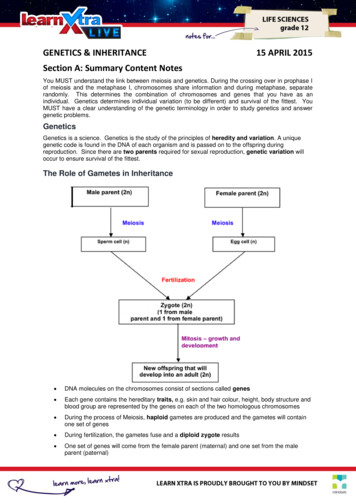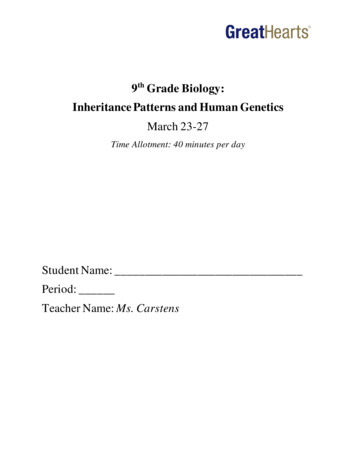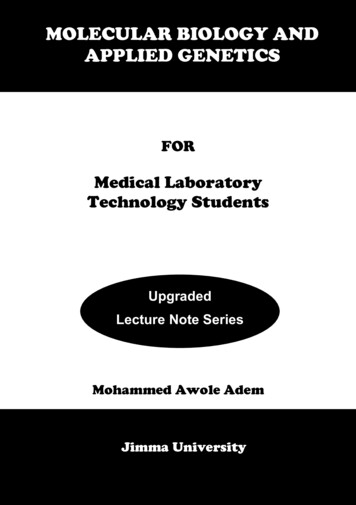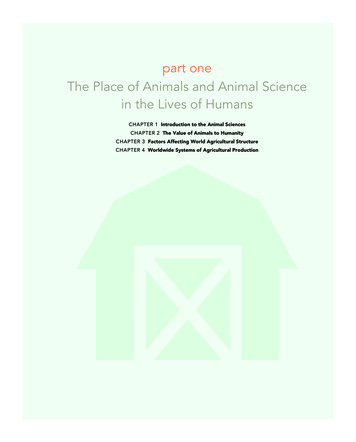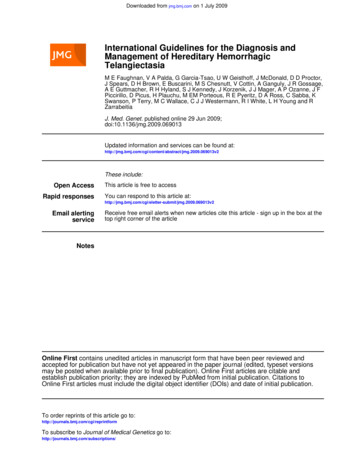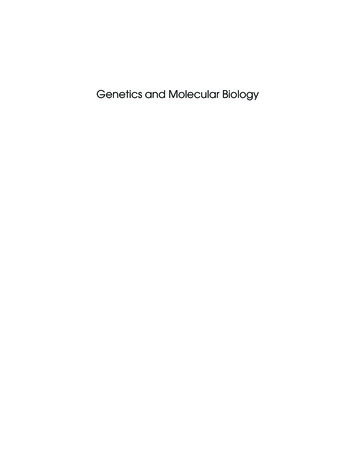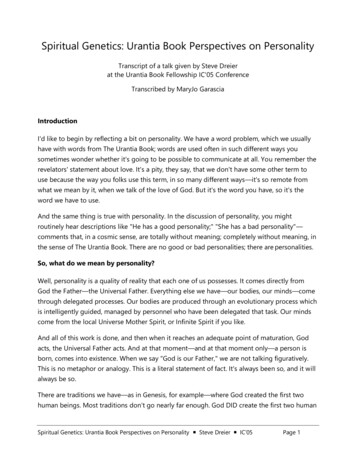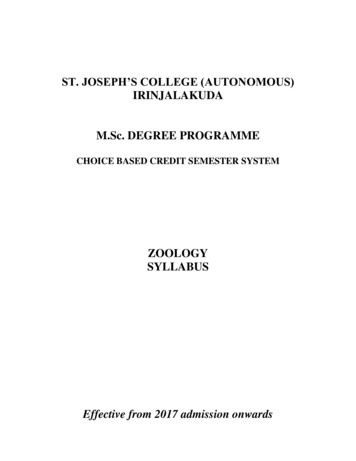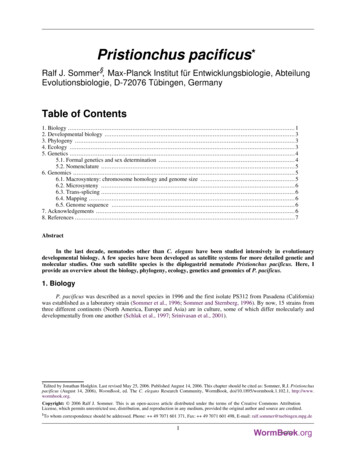
Transcription
Understanding Geneticsand theSire Summaries1
UnderstandingGeneticsand theSire SummariesThe goal of this workbook is to give young people abasic understanding of dairy cattle genetics and howit applies to their animals. It also includes a sectionabout the genetic evaluation system anda guide to reading and understanding the HolsteinAssociation USA Sire Summaries.2updated April 2021
Table of Contents5BASIC BIOLOGY OF GENETICS6EXPRESSION OF GENESMaking Sense Of The Genetic PuzzleRecognized Recessive & Dominant Traits & Conditions In Holstein Cattle9MAKING GENETIC PROGRESSFactors Influencing Genetic ProgressLooking At Genetic Variation From Two Extremes: Inbreeding & Outcrossing11 THE IMPACT OF ENVIRONMENT11 GENETICS & TECHNOLOGYEmbryo Transfer (ET)In Vitro Fertilization (IVF)Genomics3
Table of Contents(Continued)13 THE U.S. DAIRY GENETIC EVALUATION SYSTEMStandardizing EvaluationsHow Genetic Values Are Expressed15 THE HOLSTEIN ASSOCIATION USA SIRE SUMMARIESLinear Composite IndexesTotal Performance Index (TPI )Sections In The Red Book18 HOW TO READ AND INTERPRETHOLSTEIN SIRE INFORMATIONBlock A: Identification & Pedigree InformationBlock B: Production Genetic ValuesBlock C: Health Trait Information & Additional IndexesBlock D: Type InformationBlock E: Ownership InformationBlock F: NAAB InformationBlock G: Trait Name BlockBlock H: Standard Transmitting Abilities (STAs)Block I: Biological ExtremesBlock J: Trait Profiles27 CASE STUDY EXERCISE #1 – HOLSTEIN COAT COLOR29 CASE STUDY EXERCISE #2 – POLLED HOLSTEIN CATTLE31 UNDERSTANDING GENETIC PROGRESS WORKSHEET33 ANSWER KEYS4
Basic Biology of GeneticsWhat color eyes do you have? What is your hair color? How tall are you? How fast can you run? If you have siblings,you know that you are all different in many ways, but you can also probably notice some similarities in yourappearance and abilities. It’s also likely that some of those similarities can be seen in your parents. Many of those traitscan be credited, at least in part, to your genetics. Through this workbook we will explain the science behind geneticsand explore some real world, practical applications.First, let’s look at how genetic information is contained in our bodies. The components that make up geneticinformation are very similar, whether you’re studying humans, cattle, or any other organism. Every living thingis made up of millions of cells. A cell is the smalleststructural unit of an organism that is capable ofindependent function. Looking inside of a cell, you willfind a structure known as the nucleus, which serves asthe nerve center of cellular activity.All of an animal’s genetic information is housed withinthe nucleus of a cell, in the form of chromosomes. Eachspecies of animal has a specific number of chromosomes.For example, humans have 23 pairs of chromosomes (fora total of 46), and cattle have 30 pairs (for a total of 60chromosomes). Of those, 1 pair are the sex chromosomes(determine whether the calf is male or female, plus someother physical characteristics), and the other 29 pairs are“autosomal chromosomes” and determine the rest of thebody’s makeup.Chromosomes are made up of many strands of DNA(deoxyribonucleic acid). DNA are “ladder-shaped”chains of information formed by complementary basepairs. This ladder appears “twisted,” a shape known asa “double helix.”Genes, the basic units of inheritance,are specific portions of a cell’s DNA. Each gene on achromosome has a corresponding gene in the samelocation, or locus, on a corresponding chromosome,and that corresponding gene is known as an allele. Eachgene pair (or set of alleles) codes for a specific trait, suchas whether or not a cow has horns, or what color hairthey have.KEY GENETIC TERMSNucleus: Part of the cell (located in the center) that contains an organism’s DNA.Chromosome: A “packaged bundle” of genes that determine the physical characteristics of an organism. Dairy cattlehave 30 pairs of chromosomes (for a total of 60).DNA (and complimentary base pairs): Nucleic acid that is arranged in a double helical structure. DNA strandscontain numerous genes, which are part of a larger element, the chromosome.Gene: A distinct portion of a cell’s DNA that determines a portion of an animal’s appearance, performance, behaviorand other characteristics.Allele: One component of the gene pair, which is located at a given locus, or position, on the chromosome.Locus: Region of the chromosome where a particular gene is located.5
Expression of GenesWhen discussing different traits of animals and how genes are expressed and measured, there are a few more termsto learn. First, understand the difference between an animal’s genotype and phenotype. The genotype is theactual genes an organism, such as a dairy cow, possesses for a given trait. The phenotype of an organism is physicalcharacteristics that you can observe or measure; an individual’s actual performance, such as a 305-day milk productionrecord or type classification score.When looking at phenotype, there are two types of traits — qualitative and quantitative traits. Qualitativetraits are generally those controlled by one pair of genes, where a given genotype will typically result in the samephenotype each time. Examples of qualitative traits include gender, hair color, and horns in cattle. Quantitativetraits are controlled by many genes. Each gene generally has a relatively small influence on the expression of a trait,but collectively, these genes can have large effects. Examples of quantitative traits include milk production, milkcomponent percentages, and physical traits such as stature and rump angle. Quantitative traits can be significantlyinfluenced by an animal’s environment.While gene interactions can be very complex and may seem confusing, many traits, including most qualitative traits,are controlled by single genes. The alleles, or version of the gene, an animal inherits will determine its phenotype. Ateach locus of a chromosome, there are two alleles for a specific trait. In cases where a trait is controlled by a singlegene, such as coat color or horns in dairy cattle, alleles are labeled as dominant or recessive. Dominant traits willbe expressed when at least one version of the dominant allele is present; dominant alleles are typically symbolized bycapital letters, such as an “AA” genotype. Recessive traits will only be expressed when two copies of the recessiveallele are present; recessive alleles are typically symbolized by lowercase letters, such as an “aa” genotype.Organisms inherit two versions of an allele from their parents (one allele from each parent). In simple cases ofdominant/recessive genes, the pairing of alleles in a genotype can occur in three ways: Homozygous dominant means that both alleles were inherited in the dominant form, such as “AA.”To help you remember, the prefix “homo-” means “same.” Homozygous recessive means that both alleles were inherited in the recessive form, such as “aa.” Heterozygous means that one dominant allele was inherited from one parent, and one recessive allelewas inherited from the other parent, written as “Aa.” To help you remember, the prefix “hetero-” means“different.”Sometimes an animal’s genotype is not easily determined just by looking at its phenotype – animals that areexpressing a dominant trait can either be homozygous for that trait (have two copies of the dominant allele), orheterozygous for the trait (one copy of the dominant allele and one copy of the recessive allele).Animals that are heterozygous for recessive traits are commonly called “carriers” because, even though they don’texpress the recessive gene, they still carry it and may pass it on to their offspring. Looking at an animal’s pedigreecan sometimes help determine whether or not an animal is a carrier or homozygous. If a question exists after lookingat the pedigree, consult with your breed organization to see if a genetic test could be performed to determine theanimal’s genotype for the trait.Recessive traits can have a positive impact, negative impact, or be neutral, having neither a positive or negativeimpact on an animal. Neutral or positive traits would include traits such as coat color. Negative traits would beheritable defects that may cause poor health or death. Genetic ailments such as this are generally controlled by onegene. For more on these traits, see page 8.6
MAKING SENSE OF THE GENETIC PUZZLEA Punnett Square is a simple way to predict the possible genetic combinations from the mating of two individuals.To use a Punnett Square, draw a box with four squares inside of it. Across the top, list the gene combination of thesire (father), and down the left side, list the gene combination of the dam (mother). Then, bring one value from eachparent into the corresponding box within the square. Looking at the results will give you the probability of offspringborn expressing the trait you are looking at.A Punnett square looks like this:This example looks at mating two animals that are both heterozygous for trait “R”, so their genotypes areboth “Rr.”RRrrRR RrRr rr1/4 (or 25%) Homozygous Dominant (RR)2/4 (or 50%) Heterozygous (Rr)1/4 (or 25%) Homozygous Recessive (rr)There are many ways that dominant and recessive genes can impact an animal’s phenotype, including simpledominance, which can explain many common traits in dairy cattle. Other types of dominance include incompletedominance and codominance, and more clear-cut examples can be found in the plant kingdom than in dairy cattle.If you’re interested in learning more about different types of inheritance, ask a parent or teacher to help you to dosome research. Some example search topics could include Gregor Mendel, Laws of Mendelian Inheritance, incompletedominance, codominance. Genetics is a very interesting topic and many resources are available online to help youlearn more.NLEARWhat does this all mean and how is it useful? Turn to page 27 to complete the case study exerciseson bovine coat color and the polled gene and learn more about using Punnett Squares to determinephenotype from genotype.7
RECOGNIZED RECESSIVE & DOMINANT TRAITS& CONDITIONS IN HOLSTEIN CATTLEAll dairy breed associations recognize recessive and dominant traits and conditions for their breed, and label themwith specific codes on animals’ pedigrees and genetic evaluations so information is readily available to breeders. Fewdominant traits are recognized in Holstein cattle. The polled trait is one example of a dominant trait; polled cattlenaturally never grow horns, while non-polled cattle develop horns normally, as most dairy producers are familiar with.More recessive than dominant traits are recognized and labeled in the Holstein breed. Most are known as undesirablerecessives, being defects that, if inherited in a homozygous form, may cause poor health and/or death. Thesequalitative traits are generally controlled by only one gene, so if the animal is homozygous for that recessive allele,the undesirable condition is expressed.Not all recessive traits are negative. For example, red coat color in Holsteins is a recessive trait and is sometimesselected for by breeders desiring red and white Holsteins. The following table lists some common gene codes foundon Holstein pedigrees. Seeing this code for a recessive trait on an animal’s pedigree would mean that they are acarrier for the trait (do not express the actual trait). Seeing the code for a dominant trait would mean that the animalexpresses the trait, as they only need one allele to express it.Holstein Gene CodesBLBovine Leukocyte Adhesion Deficiency (BLAD)*POObserved Polled**BYBrachyspina*PCTested Heterozygous Polled**CDCholesterol Deficiency*PPTested Homozygous Polled**CVComplex Vertebral Malformation (CVM)*RCCarrier of Recessive Red Coat Color*DPDeficiency of Uridine Monophosphate Synthase(DUMPS)*B/RBlack/Red Coat Color*MFMulefoot (Syndactyly)*DR1Tested Heterozygous for DominantRed**DR2Tested Homozygous for DominantRed**Note: This is not an exhaustive list.* denotes a recessive trait**denotes a dominant traitIf an animal is tested free of a trait (meaning they do not carry any alleles for the trait), that result is also recordedand published on pedigrees and genetic evaluations. If the animal is not a carrier, they cannot pass those genes downto the next generation.Tested-Free Codes8TLTested free of BLADTDTested free of DUMPSTYTested free of BrachyspinaTMTested free of MulefootTCTested free of Cholesterol DeficiencyTPTested free of the Polled Condition (horned)TVTested free of CVMTRTested free of Recessive Red Coat Color
Making Genetic ProgressNow that you understand the basic biology of how genetics work, the next important concept to understand isgenetic change and the factors which influence it. The primary goal of most dairy producers is to maximize theprofitability of their herd. One way to achieve this goal is to have genetically superior cattle. As an importantfoundation of a profitable herd, genetic change is permanent and accumulates over time.Genetic change is dependent on four major factors:1.Accuracy of Selection refers to a breeder’s ability to select animals that truly are genetically superior for agiven trait, and is dependent on evaluation techniques, phenotypes and heritability.2.Selection Intensity is dependent on the proportion and quality of animals kept as parents (breeding stock)for the next generation. The more intense the selection, the more superior a group of animals is compared tothe overall population.3.Genetic Variation indicates the relative differences among animals that are controlled by genetic factors.It is a function of the heritability of a trait. Genetic variation can be greatly influenced by things such asinbreeding, outcrossing, or crossbreeding, which we will discuss more later in this section.4.Generation interval is the average age of a parent when offspring are born.In general, genetic change can be predicted by the following equation, which clearly shows the relationship betweenfactors.Accuracy of Selection x Selection Intensity x Genetic VariationGeneration Interval Genetic ChangeHeritability is the proportion of variation in a trait due to genetic factors, and is measured in numbers ranging from0 to 1.0. The higher the number, the more heritable the trait is, and the faster one can make genetic progress byselecting for that trait. Traits with very low heritability, those less than 0.1, do not offer much opportunity for rapidimprovement.Heritabilities of Holstein Association USA Type abilityStature0.42Rear Legs-Rear View0.11Udder Depth0.28Strength0.31Foot Angle0.15Front Teat Placement0.26Body Depth0.37Feet & Legs Score0.17Rear Teat Placement0.32Dairy Form0.29Fore Attachment0.29Teat Length0.26Rump Angle0.33Rear Udder Height0.28Final Score0.29Thurl Width0.26Rear Udder Width0.23Rear Legs-Side View0.21Udder Cleft0.24For example, imagine a cow in your herd needs improvement in both foot angle and teat placement. With aheritability for foot angle of 0.15 and a heritability for front teat placement of 0.26, which trait could you expect tomake more progress on through selection? The answer is front teat placement, because of the higher heritability.Both the heritability of a trait and the relative economic relationship of the trait to overall profitability should beconsidered when determining which traits to incorporate into a breeding program.A final concept to understand with genetic progress is that correlations exist between some traits, meaning thatselecting for one trait may result in genetic changes in other traits. This occurrence is known as correlated response,and the correlations may be positive or negative. Mathematically, correlations range from -1 to 1; the closer acorrelation is to either -1 or 1, the more correlated the traits are, and more of the same genes likely control thosetraits. A value near 0 indicates that few of the same genes regulate the same traits.9
Selection for an increase in one trait can result in an increase for another positively correlated trait. For example,a correlation of 0.4 exists between milk yield and dairy form. Selection only for increased milk yield will generallyimprove dairy form, even though no direct selection was made for dairy form.On the other hand, selection for an increase in one trait can also result in a decrease in another negativelycorrelated trait. For example, a correlation of -0.35 exists between milk yield and fat percent. Selection for anincrease in milk yield will generally result in a decreased fat percent. Correlations are important to look at in abreeding program to ensure you won’t be sacrificing more than you are gaining if unfavorable correlations existbetween traits.LOOKING AT GENETIC VARIATION FROM TWO EXTREMES:INBREEDING & OUTCROSSINGAs we discussed on the previous page, genetic variation is one of the factors that influence the rate of genetic change.Two breeding philosophies seen in dairy cattle breeding relate directly to genetic variation in a dairy cattle population– inbreeding and outcrossing.Inbreeding is when two animals who are more closely related than the average population are mated. When relatedanimals are intentionally mated to increase the frequency of the favorable genes found in a family, the practice issometimes referred to as linebreeding.While linebreeding is sometimes used to amplify the favorable genes in a family, the practice may also result in anincreased concentration of any undesirable genes found in the bloodline, which may reduce health, vigor and growthand increase calf mortality.Production and reproduction are also negatively impacted by inbreeding. For each one percent increase in inbreeding,a cow will, on average, lose 60 pounds of milk production annually. The table below shows average inbreeding levelsfor five major U.S. dairy breeds and how they have changed over time. Breeds with larger populations have lowerinbreeding coefficients. However, as you can see, average inbreeding levels for all of the breeds have increased overthe past decade, so inbreeding is something that today’s breeders should be aware of and take into considerationwhen mating their cattle. It is important to remember inbreeding is on a mating-by-mating basis and can be correctedin one generation.Breed2007Average Inbreeding (%)2017Change over thepast decadeAyrshire5.766.80 1.04Brown Swiss5.436.88 1.45Guernsey6.247.63 1.39Holstein5.327.16 1.84Jersey6.777.78 1.01Source: Council on Dairy Cattle Breeding (CDCB), 2018Outcrossing occurs when animals less related than the average population are mated. Outcrossing increasesheterozygosity. A continuing challenge of any breed is to identify superior genetics from animals less related tothe average breed population. Crossbreeding is a special form of outcrossing and occurs when two purebredsof different breeds are mated. The purpose of crossbreeding is to produce a generation that will have greaterperformance than expected, considering the genetic merit of the parents. The first generation of crossbred animalsgenerally has increased health, vigor, and reproductive performance, a phenomenon known as hybrid vigor.However, crossbreeding is not a practice recommended by many breeders, because the offspring of crossbred cattledo not typically exhibit the same hybrid vigor as their parents. Crossbred dairy cattle are also unable to provide extraprofit through marketing genetics.NLEAR10Turn to page 31 to test your skills and see how well you understand how to influence genetic change!
The Impact of EnvironmentWhen someone clones an EX-95 point cow that has made 40,000 pounds of milk, they are guaranteed that herclones will also score EX-95 and make over 40,000 pounds of milk in a single lactation, right? They might, but it’s notlikely. When breeding cattle and working to make genetic progress, it’s important to understand that an animal’sperformance isn’t solely determined by their genetic makeup.The environment where an animal is raised and lives has a large influence on things like milk production, stature, andother quantitative traits. In fact, environment contributes more to the difference among cows’ milk production thangenetics does; 75 percent of milk production performance is attributed to environment, while only 25 percent is basedon genetic merit. Environmental variance is the term used to describe the difference in performance of animalsthat is caused by environmental effects. Genetic evaluations are designed to account for differences in production andtype due to environmental variance.Genetics & TechnologyGenetics is an exciting field because it is ever changing. New discoveries and advancements are made each year thatprovide cattle breeders with additional tools to improve their herds and breed higher quality cattle. In this section wewill cover some advanced technologies that have an impact on dairy cattle breeding today.EMBRYO TRANSFER (ET)Embryo transfer, commonly known as “flushing,” is a tool that has been around for decades, and allows breeders toproduce more offspring from their most superior animals in a shorter period of time.Embryo transfer can be performed on any non-pregnant heifer (as long as she has reached sexual maturity) or cow, andis done by veterinarians or other trained professionals. The cow or heifer that is being flushed (known as the “donordam”) is given a series of hormone injections over a specific timeframe. This causes her to produce a higher than normalnumber of eggs, known as superovulation. Typically, five days after the first injection, the donor dam is bred. Six toeight days later, the embryos are recovered, by “flushing” them from the uterus. The ET technician examines the eggsunder a microscope to determine the number and quality. The viable (fertilized) embryos are then either implanted intorecipient animals (which will carry the calf and give birth to it, like a surrogate) that have been synchronized to be at thesame reproductive phase as the donor dam, or they will be frozen and implanted at a later date.Embryo transfer increases genetic progress as it increases selection intensity (using a smaller number of the most elitecows as dams of many offspring) and may decrease the generation interval (as heifers may be flushed sooner thanthey would normally be able to give birth to a calf).IN VITRO FERTILIZATION (IVF)In vitro fertilization is a process somewhat similar to ET, increasing in popularity as another option for breeders to getmore offspring from their most valuable animals in a shorter period of time. “In vitro” is a Latin phrase, translating to“in the glass,” meaning that with IVF, fertilization of the oocytes (eggs) literally occurs “in the glass” in the laboratory,in a petri dish or test tube, as opposed to embryo transfer, where fertilization of the eggs occurs inside the cow, andembryos are collected from the cow.With IVF, unfertilized oocytes are harvested directly from the ovaries of the donor dam by a skilled veterinarian, aprocess called an aspiration. After being allowed to mature for 20-24 hours, the oocytes are then fertilized in a petridish. Next, eggs are placed in an incubator to grow for a week, in a controlled environment designed to imitate theconditions of a cow’s uterus. Finally, viable embryos are implanted into synchronized recipient animals, seven daysfollowing the recipient’s standing heat, much like with embryo transfer. IVF embryos may be frozen, but the highestsuccess rates are seen when they are implanted fresh.While there are some similarities between IVF and ET, there are a few key differences. IVF may be performed on pregnantfemales (as well as open cows and heifers), typically in a window of the first 40 to 100 days of pregnancy. While theprocedure is consider to be quite safe, there is a slight risk of pregnancy loss as the donor cow’s reproductive tract is beinghandled. IVF can also be performed more frequently than ET work; oocytes may be collected as often as every other week(under a veterinarian’s advisement), whereas most ET programs will collect embryos from the donor dams about every 60days. Finally, since fertilization is taking place outside of the cow, one unit of semen may be used to fertilize eggs fromseveral donor dams, or, semen from several different bulls can be used to fertilize eggs harvested from one elite cow.11
GENOMICSGenomic testing is the process of taking a DNA sample from an animal and analyzing it to determine which genes arepresent in the animal and may be expressed. It gives a much more accurate picture of an animal’s genetic potentialand increases the reliability of an animal’s genetic evaluation over traditional methods.Genomic testing became commercially available to the dairy industry in 2009 and has had a significant impact on theHolstein breed over the past decade, with hundreds of thousands of new Holsteins being tested each year. The mostcommon types of DNA samples submitted for testing are hair (pulled from the switch) or tissue (punched from theear with a special collection tube). The process of obtaining genomic results is very simple. First, take a DNA samplefrom the animal(s) you are interested in testing. Next, order your test from a genomic test provider, such as HolsteinAssociation USA. Your test provider will send you information on how to send your DNA sample off to the laboratory,where the actual genotyping is performed. At the lab, the DNA is extracted and a genotype is compiled, which is thensent on to the Council on Dairy Cattle Breeding (CDCB) for analysis. The CDCB distributes genomic PTAs back to thetest providers, who then delivers your results. The process typically takes three to five weeks from the time the DNAsample arrives at the lab until your results are returned.Most bulls used for breeding purposes, including the vast majority of those used for artificial insemination, have beengenomic tested and many breeders are testing their females so they can make more informed breeding and selectiondecisions. Here are some common uses for genomic information: For herds with extra replacement heifers – testing heifers in the group they are considering selling as asorting tool to help ensure they are keeping the best group of females for their operation. For herds doing ET and IVF work, or looking to grow their herd internally – using genomic results todetermine which females should be donor dams, or bred to sexed semen, and which are better suited tobe bred with conventional semen or used as recipients. Genomic information can also be useful to screenpotential recipients for fertility and calving traits, to be sure that those animals who will be implantedwith high-value embryos are genetically predisposed to conceive and have a live calf.Aside from the genomic PTAs which delivered back from the genomic test, there is a wealth of other informationgleaned from that DNA sample. First, all animals being genomic tested have their parentage verified as the firststep of the process – so if an animal is genomic tested, you can be sure that their parentage is correct. Animals arealso screened for several of the genetic conditions that may affect the breed (see page 8 for more information ongenetic conditions). Official genetic test results may be added on to a genomic test (sometimes for additional fees). Inadditional, several haplotype results will be delivered, for no additional fees.A haplotype is a combination of alleles (DNA sequences) at different locations on a chromosome that are transmittedtogether as a group (linked). These can be used to give a good indication as to whether or not an animal is a carrierof a genetic condition, but they are not 100 percent accurate. For more information on haplotypes and other geneticconditions, visit www.holsteinusa.com.Remembering back to the formula for genetic progress, technologies such as ET/IVF and genomic testing areinfluencing every piece of the equation, and we are seeing genetic progress in the Holstein breed increase at anincreasing rate because of it. Additionally, we are seeing the negative trend observed in some of the health traitsreversed due to the ability to make more intensive and accurate selection decisions to improve on those traits.Holstein Genetic Progress for Net MeritHolstein Genetic Progress for Daughter Pregnancy RateSource: CDCB, 2018NLEAR12For the most up-to-date information about genomic testing in Holstein cattle,visit www.holsteinusa.com/programs services/genomics.html.Source: CDCB, 2018
The U.S. Dairy Genetic Evaluation SystemThe goal of any breeder should be to improve the quality of the next generation of his or her herd with each calf thatis born, and genetic evaluations are a critical tool used to achieve that. The U.S. dairy genetic evaluation system is veryimportant in providing accurate information about genetic merit of cattle to dairy producers. Official genetic evaluationsare released three times annually, in April, August, and December. Genetic and performance data is supplied byorganizations such as the dairy breed associations and Dairy Herd Information Associations (DHIAs) to the Council on DairyCattle Breeding (CDCB) to be incorporated into evaluation calculations.Genetic evaluations for type and production in the United States are computed using Animal Model procedures forestimating Predicted Transmitting Abilities (PTAs). PTAs are an estimate of genetic superiority (or inferiority) that abull or cow will transmit to their offspring for a given trait, and will be discussed in more detail in the next section.Animal Model evaluations are based on an animal and its relationship to other animals being evaluated. Informationfrom the animal itself, its ancestors, and its progeny is all incorporated, with all known relationships among theanimals being considered. In an Animal Model evaluation, all identified relatives of an animal affect t
on Holstein pedigrees. Seeing this code for a recessive trait on an animal's pedigree would mean that they are a carrier for the trait (do not express the actual trait). Seeing the code for a dominant trait would mean that the animal expresses the trait, as they only need one allele to express it. Holstein Gene Codes
